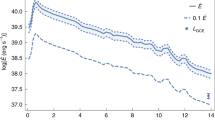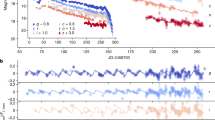Abstract
The recent report that two millisecond pulsars were found in the globular cluster 47 Tuc1, together with the previous discoveries in the clusters M282, M43 and M154, indicates that formation of millisecond pulsars in globular clusters is greatly enhanced over the field, where a fourth example has recently been found5. This excess appears to be even larger than that for low-mass X-ray binaries (LMXBs), which show a factor of 100 excess (per unit mass) in globular clusters as opposed to the Galaxy6,7. If the birthrate of millisecond pulsars is indeed greater than that of LMXBs in clusters, then, contrary to the common assumption8, LMXBs cannot be the sole precursors of millisecond pulsars. Here we suggest instead that accretion-induced collapse of white dwarfs in binaries9 can form millisecond pulsars directly, without requiring a precursor LMXB stage10. Ablation of the pre-collapse binary companion by the millisecond pulsar's radiation field11, a process invoked to explain some of the characteristics of the recently discovered eclipsing millisecond pulsar5,12,13, can then yield isolated neutron stars without requiring an additional stellar encounter.
This is a preview of subscription content, access via your institution
Access options
Subscribe to this journal
Receive 51 print issues and online access
$199.00 per year
only $3.90 per issue
Buy this article
- Purchase on Springer Link
- Instant access to full article PDF
Prices may be subject to local taxes which are calculated during checkout
Similar content being viewed by others
References
Ables, J. et al. IAU Circ. no. 4602 (1988).
Lyne, A. G. et al. Nature 328, 399–401 (1987).
Lyne, A. G. et al. Nature 332, 45–47 (1988).
Wolszczan, A. et al. IAU Circ. no. 4552 (1988).
Fruchter, A., Strinebring, D. & Taylor, J. Nature 333, 237–239 (1988).
Katz, J. I. Nature 253, 698–699 (1975).
Clark, G. Astrophys. J. 199, L143–L145 (1975).
Van den Heuvel, E. P. J. in Origin and Evolution of Neutron Stars (eds Helfand, D. & Huang, J.) 393–406 (IAU Symp. 125, 1987).
Grindlay, J. in Origin and Evolution of Neutron Stars (eds Helfand, D. & Huang, J.) 173–186 (IAU Symp. 125, 1987).
Chanmugam, G. & Becher, K. Nature 329, 696–698 (1987).
Ruderman, M. et al. submitted to Astrophys. J.
Kluzniak, W., Ruderman, M., Shaham, J. & Tavani, M. Nature 334, 225–227 (1988).
Phinney, E. S., Evans, C. R., Blandford, R. D. & Kulkarni, S. R. Nature 333, 832–834 (1988).
Nomoto, K. in Origin and Evolution of Neutron Stars (eds Helfand, D. & Huang, J.) 281–304 (IAU Symp. 125, 1988).
Verbunt, F. & Hut, P., in Origin and Evolution of Neutron Stars (eds Helfand, D. & Huang, J.) 187–198 (IAU Symp. 125, 1987).
Taam, R. E. & van den Heuvel, E. P. J. Astrophys. J. 305, 235–245 (1986).
Webbink, R. Astrophys. J. 277, 355–360 (1984).
Verbunt, F. in The Physics of Neutron Stars and Black Holes (ISAS, Tokyo, 1988).
Bailyn, C. & Grindlay, J. Astrophys. J. 316, L25–L29 (1987).
Bailyn, C. Nature 332, 330–332 (1988).
Verbunt, F. & Rappaport, S. Astrophys. J. 332, 193–198 (1988).
Grindlay, J. in Globular Cluster Systems in Galaxies (eds Grindlay, J. & Philip, A. G. D.) 347–366 (IAU Symp. 126, 1987).
Verbunt, F., van den Heuvel, E. P. J., van Paradijs, J. & Rappaport, S. A. Nature 329, 312–314 (1987).
Krolik, J., Meiksin, A. & Joss, P. Astrophys. J. 282, 466–480 (1984).
Bailyn, C. thesis, Harvard Univ. (1987).
Ostriker, J. in Dynamics of Star Clusters (eds Goodman, J. & Hut, P.) 347–357 (IAU Symp. 113, 1985).
Verbunt, F. & Meylan, G. Astr. Astrophys. (to appear).
Grindlay, J. in Evolution of Galactic X-ray Binaries (eds Trumper, J., Lewin, W. H. G., & Brinkmann, W.,) 25 (NATO ASI Ser., 1986).
Lightman, A. & Grindlay, J. Astrophys. J. 262, 145–152 (1982).
Van den Heuvel, E. P. J., van Paradijs, J. & Taam, R. Nature 322, 153–155 (1986).
Author information
Authors and Affiliations
Rights and permissions
About this article
Cite this article
Grindlay, J., Bailyn, C. Birth of millisecond pulsars in globular clusters. Nature 336, 48–50 (1988). https://doi.org/10.1038/336048a0
Received:
Accepted:
Issue Date:
DOI: https://doi.org/10.1038/336048a0
This article is cited by
-
Primordial black holes in globular clusters
Nature (1993)
-
Discovery of ten millisecond pulsars in the globular cluster 47 Tucanae
Nature (1991)
-
Genesis of pulsars in globular clusters
Nature (1990)
Comments
By submitting a comment you agree to abide by our Terms and Community Guidelines. If you find something abusive or that does not comply with our terms or guidelines please flag it as inappropriate.



